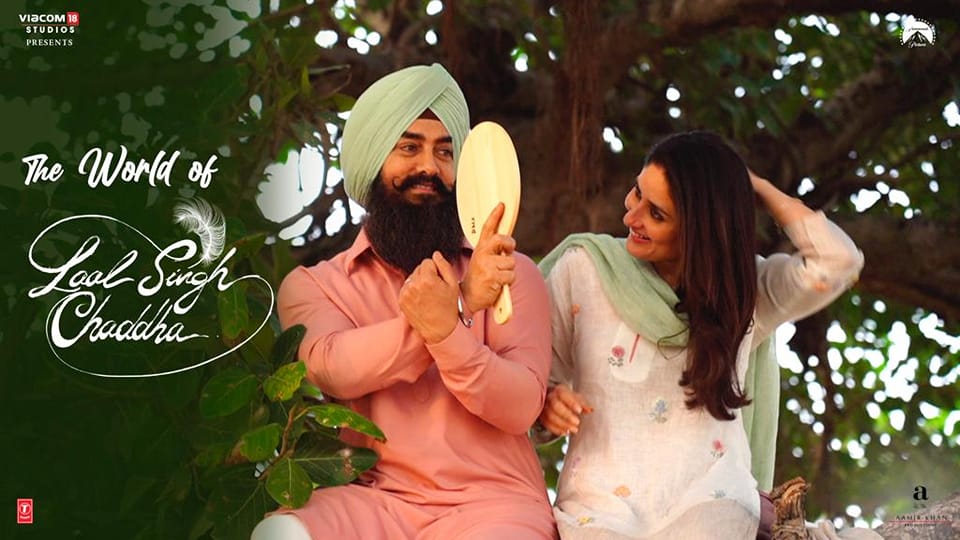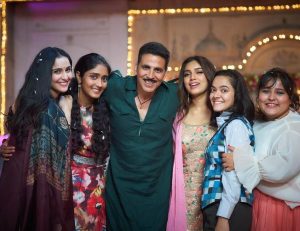Reasons: Changing audience tastes, poor content, high ticket prices, early OTT releases, nepotism, and political affiliations.

Aamir Khan and Kareena Kapoor-starrer Laal Singh Chaddha is the latest to join the list of Bollywood flops this year. (aamirkhanproductions/Facebook)
Aamir Khan’s much-hyped Laal Singh Chaddha and Akshay Kumar’s Rakhsa Bandhan are the latest big Hindi films that have joined the list of Bollywood flops this year.
Samrat Prithviraj, Dhaakad, Jayeshbhai Jordaar, Runway 34, Heropanti 2, Bachchan Paandey, Radhe Shyam and Shamshera all failed to bring the crowds back to the theatres in 2022.
In contrast, south Indian films like Pushpa, RRR and KGF2 have minted money not only in India but also in the overseas markets.
Relatively smaller releases like Major, Charlie 777, Vikram, Sita Ramam, Bimbisara, Jana Gana Mana, and Hridayam have all struck gold at the box office as well.
The audience is flocking to the cinema halls and the pandemic seems to be a thing of the past.
One of the reasons attributed to the failure of the A-lister Hindi films is the content itself and not the star cast, experts say.
With the pandemic and lockdowns, the audience was forced to sign onto OTT platforms for their daily source of entertainment. Needless to say, this opened up a whole new world of content for them.
The south Indian film industry has always been content- and story-driven rather than focusing on over-the-top action and glamour.
The quality of films produced is also much better, even for a small budget (less than ₹5 crore) film. This is exactly where they score.
#Pushpa and more recently, #Karthikeya2 were released with zilch promotions/media interviews, yet the content of these two films spoke louder than words… On the other hand, several biggies – including #Shamshera – had countless media interactions before release… Kya hua?
— taran adarsh (@taran_adarsh) August 23, 2022
The success of Kashmir Files and Rocketry, for instance, has shown that if you have strong content that appeals to a lot of people, you don’t need big budgets and A-list stars to deliver hits.
According to a recent report by Emkay Global Financial Services, “Historically, Bollywood films have seen decent collections even when the content was weak, given the strong fan following of superstars. That seems to have changed with time, with content now being the primary driver.”
“Of late, Bollywood’s nature of narratives is outdated, with nothing to offer in terms of storytelling. I have a feeling that if the films that are being made in Bollywood were made in the South, one would witness a significant difference in the level of conviction of staying true to the facts and nativity,” Kannada film producer Harish Mallya told South First.
“It also seems like the south Indian film industry not only knows about the taste of local audiences but is also aware of what the average audience from other parts of the country would accept.”

Akshay Kumar’s Raksha Bandhan turned into a box office dud, despite the hype. (Akshay Kumar/Facebook)
The changing interests of the audience have left the producers confused. Given that many of these films were greenlit before the start of the pandemic, the results being seen at this point have been catastrophic for the Hindi film industry.
Other issues like nepotism, cliques, political affiliations, and calling for boycotts have also affected Bollywood in the last few years. But these are passing clouds and, ultimately, issues like what a film is all about and whether or not it appeals to the audience determine its success or failure.
Another factor that is also affecting the footfalls in theatres is the ticket prices in the Hindi-speaking regions.
If a family of four has to visit a theatre, a minimum spend of ₹3,000 (conservatively) is required on a weekday, whereas that is not the case in the South.
Over the weekends, ticket prices in the national chains can go above ₹1,000 per ticket even for a mid-budget film. This is very much unlike the southern cinemas where ticket prices are quite accessible to the common man.
So, unless a Hindi film is compelling enough, the audience is not willing to shell out big bucks today. For, spending habits have changed drastically after the pandemic.
When it comes to ticket prices, we also need to talk about the pricing of OTT platforms. When a movie is dropped on OTT, within a few weeks of its theatrical release, the audience feels that it’s cheaper to watch it at home at one’s convenience.
The yearly subscriptions for OTT platforms are often cheaper than a movie ticket and it becomes economical for the audience to invest in those rather than movie outings every other week.
#Jailer begins his action Today!@rajinikanth @Nelsondilpkumar @anirudhofficial pic.twitter.com/6eTq1YKPPA
— Sun Pictures (@sunpictures) August 22, 2022
Many of the southern films that have done well this year are those that have grandiose sets, peppy songs, well-choreographed action scenes, and are technically really good.
These films, when dubbed and released, also did well in the Hindi belt, thanks to these factors.
Tamil film producer G Dhananjayan observes: “The South film industry has been continuously churning out mass entertainers with big heroes which Bollywood has not done recently with heroes like Salman or Shah Rukh.”
“Aamir’s Laal Singh Chaddha is a more artistic film and a remake of Forrest Gump. In this age of OTT, such remakes won’t work, especially in the case of such a big cult film.”
In the age of the OTT, the audience is clearly looking for theatrical experience films and such films are not being made in Hindi right now.
“However, I am confident that Ranbir Kapoor-Alia Bhatt’s Brahmastra, releasing in September, will do well and could change the tide. This movie has a visual grandeur with a cinematic experience thanks to its CG work and looks appealing. I think it will bring back the audience,” he said.
Meanwhile, other filmmakers in south cinema talk about the quality of production and the right casting.
Introducing – Music Director Murali Gopy ? #Theerppu Song! https://t.co/U9wCSFThAC pic.twitter.com/gJUXQYvyzp
— Prithviraj Sukumaran (@PrithviOfficial) August 23, 2022
For instance, The Great Indian Kitchen was reportedly made on a budget of ₹1 crore by Jeo Baby. The excellent script was brought to life by Nimisha Sajayan and Sooraj Venjaramoodu.
Though not A-listers in Malayalam cinema, they are superb actors in their own right. Before the release, Jeo Baby announced that The Great Indian Kitchen is a universal story that will connect to women across India, and it did.
Filmmakers in the Hindi film industry need to go back to the drawing board to ensure that they narrate stories along with all the other aspects that Hindi cinema was always known for.
Let’s hope that Brahmastra would be a turning point for the filmmakers in Bollywood!

May 13, 2024

May 12, 2024

May 10, 2024

May 09, 2024

May 09, 2024

May 07, 2024